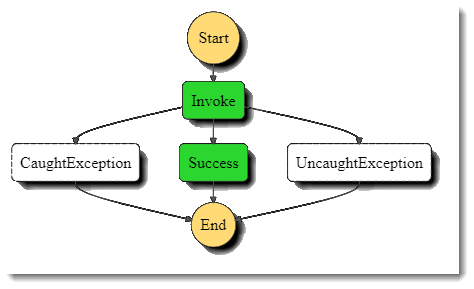Orchestration examples with Step Functions
All work in your Step Functions state machine is done by Tasks. A Task performs work by using an activity, a Lambda function, or by passing parameters to the API actions of other Supported AWS Service Integrations for Step Functions.
Sections
Configuring a Lambda function as a task
Step Functions can invoke Lambda functions directly from a Task state in an Amazon States Language
definition.
... "MyStateName":{ "Type":"Task", "Resource":"arn:aws:lambda:us-west-2:01234567890:function:my_lambda_function", "End":true ...
You can create a Task state that invokes your Lambda function with the input to the state machine or any JSON document.
Example event.json
{ "max-depth": 10, "current-depth": 0, "error-rate": 0.05 }
Configuring a state machine as an event source
You can create a Step Functions state machine that invokes a Lambda function. The following example shows a Task state that invokes version 1 of a function named my-function with an event payload that has three keys. When the function returns a successful response, the state machine continues to the next task.
Example state machine
... "Invoke": { "Type": "Task", "Resource": "arn:aws:states:::lambda:invoke", "Parameters": { "FunctionName": "arn:aws:lambda:us-east-2:123456789012:function:my-function:1", "Payload": { "max-depth": 10, "current-depth": 0, "error-rate": 0.05 } }, "Next": "NEXT_STATE", "TimeoutSeconds": 25 }
Permissions
Your state machine needs permission to call the Lambda API to invoke a function. To grant it permission, add the AWS managed policy AWSLambdaRole
The FunctionName and Payload parameters map to parameters in the Invoke API operation. In addition to these, you can also specify the InvocationType and ClientContext parameters. For example, to invoke the function asynchronously and continue to the next state without waiting for a result, you can set InvocationType to Event:
"InvocationType": "Event"
Instead of hard-coding the event payload in the state machine definition, you can use the input from the state machine execution. The following example uses the input specified when you run the state machine as the event payload:
"Payload.$": "$"
You can also invoke a function asynchronously and wait for it to make a callback with the AWS SDK. To do this, set the state's resource to arn:aws:states:::lambda:invoke.waitForTaskToken.
For more information, see Invoke Lambda with Step Functions in the AWS Step Functions Developer Guide.
Handling function and service errors
When your function or the Lambda service returns an error, you can retry the invocation or continue to a different state based on the error type.
The following example shows an invoke task that retries on 5XX series Lambda API exceptions (ServiceException), throttles (TooManyRequestsException), runtime errors (Lambda.Unknown), and a function-defined error named function.MaxDepthError. It also catches an error named function.DoublesRolledError and continues to a state named CaughtException when it occurs.
Example catch and retry pattern
... "Invoke": { "Type": "Task", "Resource": "arn:aws:states:::lambda:invoke","Retry": [ { "ErrorEquals": [ "function.MaxDepthError", "Lambda.TooManyRequestsException", "Lambda.ServiceException", "Lambda.Unknown" ], "MaxAttempts": 5 } ], "Catch": [ { "ErrorEquals": [ "function.DoublesRolledError" ], "Next": "CaughtException" } ],"Parameters": { "FunctionName": "arn:aws:lambda:us-east-2:123456789012:function:my-function:1", ...
To catch or retry function errors, create a custom error type. The name of the error type must match the errorType in the formatted error response that Lambda returns when you throw an error.
For more information on error handling in Step Functions, see Handling Error Conditions Using a Step Functions State Machine in the AWS Step Functions Developer Guide.
AWS CloudFormation and AWS SAM
You can define state machines using a AWS CloudFormation template with AWS Serverless Application Model (AWS SAM). Using AWS SAM, you can define the state machine inline in the template or in a separate file. The following example shows a state machine that invokes a Lambda function that handles errors. It refers to a function resource defined in the same template (not shown).
Example branching pattern in template.yml
AWSTemplateFormatVersion: '2010-09-09' Transform: 'AWS::Serverless-2016-10-31' Description: An AWS Lambda application that uses AWS Step Functions. Resources: statemachine: Type: AWS::Serverless::StateMachine Properties: DefinitionSubstitutions: FunctionArn: !GetAtt function.Arn Payload: | { "max-depth": 5, "current-depth": 0, "error-rate": 0.2 } Definition: StartAt: Invoke States: Invoke: Type: Task Resource: arn:aws:states:::lambda:invoke Parameters: FunctionName: "${FunctionArn}" Payload: "${Payload}" InvocationType: Event Retry: - ErrorEquals: - function.MaxDepthError - function.MaxDepthError - Lambda.TooManyRequestsException - Lambda.ServiceException - Lambda.Unknown IntervalSeconds: 1 MaxAttempts: 5 Catch: - ErrorEquals: - function.DoublesRolledError Next: CaughtException - ErrorEquals: - States.ALL Next: UncaughtException Next: Success CaughtException: Type: Pass Result: The function returned an error. End: true UncaughtException: Type: Pass Result: Invocation failed. End: true Success: Type: Pass Result: Invocation succeeded! End: true Events: scheduled: Type: Schedule Properties: Description: Run every minute Schedule: rate(1 minute) Type: STANDARD Policies: - AWSLambdaRole ...
This creates a state machine with the following structure:

For more information, see AWS::Serverless::StateMachine in the AWS Serverless Application Model Developer Guide.